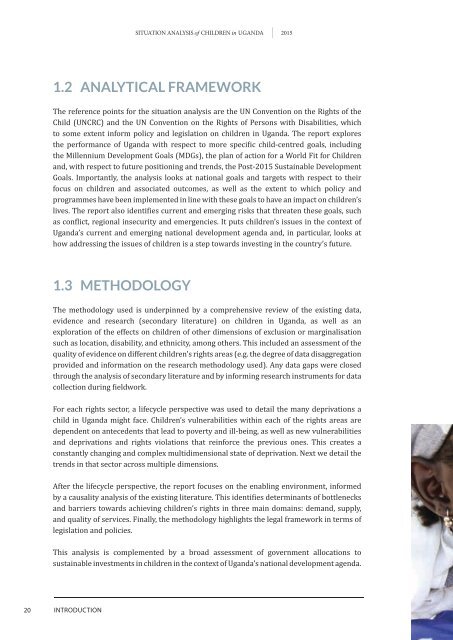Situation analySiS
1TNu802
1TNu802
You also want an ePaper? Increase the reach of your titles
YUMPU automatically turns print PDFs into web optimized ePapers that Google loves.
<strong>Situation</strong> <strong>analySiS</strong> of Children in uganda 20151.2 ANALyTICAL FRAMEWORKThe reference points for the situation analysis are the UN Convention on the Rights of theChild (UNCRC) and the UN Convention on the Rights of Persons with Disabilities, whichto some extent inform policy and legislation on children in Uganda. The report exploresthe performance of Uganda with respect to more specific child-centred goals, includingthe Millennium Development Goals (MDGs), the plan of action for a World Fit for Childrenand, with respect to future positioning and trends, the Post-2015 Sustainable DevelopmentGoals. Importantly, the analysis looks at national goals and targets with respect to theirfocus on children and associated outcomes, as well as the extent to which policy andprogrammes have been implemented in line with these goals to have an impact on children’slives. The report also identifies current and emerging risks that threaten these goals, suchas conflict, regional insecurity and emergencies. It puts children’s issues in the context ofUganda’s current and emerging national development agenda and, in particular, looks athow addressing the issues of children is a step towards investing in the country’s future.1.3 METHODOLOGyThe methodology used is underpinned by a comprehensive review of the existing data,evidence and research (secondary literature) on children in Uganda, as well as anexploration of the effects on children of other dimensions of exclusion or marginalisationsuch as location, disability, and ethnicity, among others. This included an assessment of thequality of evidence on different children’s rights areas (e.g. the degree of data disaggregationprovided and information on the research methodology used). Any data gaps were closedthrough the analysis of secondary literature and by informing research instruments for datacollection during fieldwork.For each rights sector, a lifecycle perspective was used to detail the many deprivations achild in Uganda might face. Children’s vulnerabilities within each of the rights areas aredependent on antecedents that lead to poverty and ill-being, as well as new vulnerabilitiesand deprivations and rights violations that reinforce the previous ones. This creates aconstantly changing and complex multidimensional state of deprivation. Next we detail thetrends in that sector across multiple dimensions.After the lifecycle perspective, the report focuses on the enabling environment, informedby a causality analysis of the existing literature. This identifies determinants of bottlenecksand barriers towards achieving children’s rights in three main domains: demand, supply,and quality of services. Finally, the methodology highlights the legal framework in terms oflegislation and policies.This analysis is complemented by a broad assessment of government allocations tosustainable investments in children in the context of Uganda’s national development agenda.20 INtroDUCtIoN




